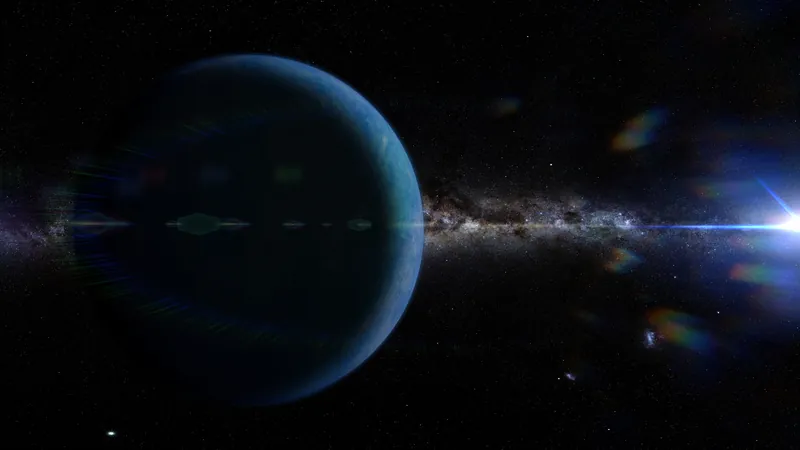
Is This the Elusive Planet Nine? Astronomers Unveil a New Candidate Beyond Neptune!
2025-05-02
Author: Kai
Astronomers Claim They've Spotted Potential Planet Nine!
In a groundbreaking study, astronomers on the hunt for a ninth planet in our solar system believe they've discovered a strong contender lurking far beyond Neptune. This revelation could mark humanity's first sighting of the long-speculated Planet Nine, theorized to be a colossal, undiscovered world orbiting our sun!
A Curious Dot in the Sky
The tantalizing candidate emerged from the analysis of old satellite data. While it currently appears as an intriguing dot in infrared imagery, its movement suggests it may indeed be a large, distant planet. Terry Phan, the lead author and an astronomy doctoral student from National Tsing Hua University in Taiwan, expressed his thrill: "I felt very excited; it's motivated us a lot!"
Skepticism Looms Over the New Findings
Although the findings have been submitted for publication, not everyone is on board. Noted Caltech astronomer Mike Brown, who was instrumental in proposing the Planet Nine hypothesis back in 2016, raised doubts about the candidate's identity. Upon calculating its orbit, Brown found the object's trajectory woefully misaligned with Planet Nine's predicted path—a tilt of roughly 120 degrees compared to the expected 15 to 20 degrees. "This doesn't mean it's not there, but it means it's not Planet Nine," he stated, suggesting it might not exert the same gravitational effects we associate with the theoretical planet.
The Search for Planet Nine's Position
The predicted location of Planet Nine has been crucial in explaining the unusual orbits of certain objects in the Kuiper Belt at the solar system's edge. However, skepticism abounds, with many scientists questioning whether these peculiar orbits truly indicate the presence of an unseen planet. The wider scientific community remains eagerly awaiting definitive observational evidence.
What If Planet Nine Is Real?
Should Planet Nine exist, early predictions suggest it is significantly larger than Earth and follows an extraordinary orbit billions of miles from Neptune. Its remote location poses a challenge for scientists striving to confirm or refute its existence.
A Deep Dive into Historical Data
In their quest, the research team scoured the archives of two retired satellites—the Infrared Astronomical Satellite (IRAS) launched in 1983 and the AKARI satellite active from 2006 to 2011. They were on the lookout for distant objects that would slowly shift between observational sets, mimicking the behavior of the hypothesized Planet Nine.
One Hopeful Candidate
After eliminating known celestial bodies, the researchers focused on a shortlist, ultimately identifying what they call "one good candidate." This dot exhibited consistent colors and brightness in two separate datasets, hinting at the prospect of it being a singular entity captured by both satellites. Further observations are paramount to determine its complete orbital characteristics.
Future Implications of the Discovery
If the infrared signal turns out to be a planet, Brown warns that it could destabilize the original Planet Nine hypothesis, indicating it might be a wholly separate celestial body. The ongoing search for Planet Nine—whether as the ninth planet or something entirely different—will remain a hot topic in the astronomical community. However, experts believe that significant revelations could surface as soon as 2025.



 Brasil (PT)
Brasil (PT)
 Canada (EN)
Canada (EN)
 Chile (ES)
Chile (ES)
 Česko (CS)
Česko (CS)
 대한민국 (KO)
대한민국 (KO)
 España (ES)
España (ES)
 France (FR)
France (FR)
 Hong Kong (EN)
Hong Kong (EN)
 Italia (IT)
Italia (IT)
 日本 (JA)
日本 (JA)
 Magyarország (HU)
Magyarország (HU)
 Norge (NO)
Norge (NO)
 Polska (PL)
Polska (PL)
 Schweiz (DE)
Schweiz (DE)
 Singapore (EN)
Singapore (EN)
 Sverige (SV)
Sverige (SV)
 Suomi (FI)
Suomi (FI)
 Türkiye (TR)
Türkiye (TR)
 الإمارات العربية المتحدة (AR)
الإمارات العربية المتحدة (AR)